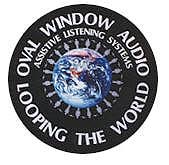Instructions for Using Your HLR III
Induction
Loop Receiver
The receiver has been loaded with a 9 volt alkaline battery and has passed quality control testing. To change the battery, carefully open the battery compartment door by gripping the sides of the front bottom panel and sliding the panel off. Following the illustration in the battery compartment, insert the new battery. For best performance, always use alkaline batteries.
1) Place the receiver in breast pocket or use the built in neck cord.
2) Plug ear bud or headphones into the jack at the top of the receiver.
3) Place ear bud(s) into ears or headphones over both ears.
4) Slowly turn the volume control until it clicks “on.” The receiver's two LED indicators will flash briefly when the unit is turned on. This confirms that the battery is good. To maximize battery life, always turn off the receiver when it is not in use.
5) Adjust volume control to a comfortable sound level. For best reception, most loop systems will require a more or less vertical/upright receiver orientation. Experiment by changing the position of the receiver while listening. For added convenience, a second volume control is built in to the headphone cord.
LED Loop Signal Check: The receiver's two LEDs provide a visual confirmation of the loop signal. The receiver must be positioned in a vertical/upright position when testing.
No LEDs = loop signal too weak
Green LED = acceptable loop signal
Green LED w/Red LED flash = good loop signal
Both LEDs on continuously = loop signal too high
For more comprehensive loop system evaluations, Oval Window Audio’s FSM Loop Test Set is recommended for certifying loop installations as per latest IEC 60118-4 standards.
Noise Filter: In environments with high levels of low frequency (60 Hz) electromagnetic noise (heard as “hum” through the receiver’s headphones), the loop receiver’s “noise filter” function may be employed. Access the noise filter feature by removing the battery and locating the switch in the battery compartment. Use a small screwdriver or pen to push the small switch to the “on” or “off” position as shown by the illustration in the battery compartment. Please contact Oval Window Audio for more information pertaining to interference mitigation.
Recharging the Induction Loop Receiver with optional charger & NiMH batteries:
IMPORTANT: THE RECEIVER MUST BE LOADED WITH THE OPTIONAL NICKEL METAL HYDRIDE (NiMH) RECHARGEABLE BATTERY AND ONLY THE OVAL WINDOW AUDIO DESIGNATED CHARGER MUST BE USED.
1) The receiver should be switched off and the NiMH battery properly inserted.
2) Charge the receiver by inserting the charger plug into the receiver’s ear/headphone jack located at the top of the unit. Prior to using for the first time the battery should be left on charge for at least 12 hours.
3) Charge after every use. The NiMH batteries will perform better and have a longer life if they are used and charged daily, usually overnight.
4) During lengthy breaks in use (e.g. extended holidays), fully charge the battery and remove it from the receiver. Place in a dry storage space. To maximize the life of the battery, do not leave on charge for extended periods (10 or more days).
Cleaning:
To clean the ear buds or headphones,
lightly dampen a paper towel with isopropyl alcohol and wipe the cushions,
headband and plug. Allow to dry before using. Headphone cushions may be
removed for washing with mild dish detergent. Replacement cushions may be
ordered.
Back to Induction Loop Assistive
Listening Systems
List, click here.
![]()
 E-mail
Oval Window Audio Today
E-mail
Oval Window Audio Today
Home // Hearing Loops // Induction Loop Assistive Listening Systems // Induction Loop Testing Equipment // Vibrotactile/Multisensory Sound Lab // ALS Pricing & Ordering // Contact Us
This site created with the help of The Write Direction
